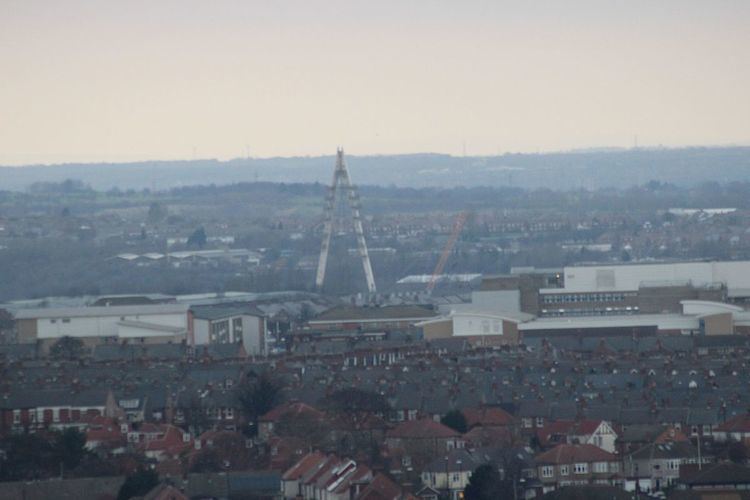Crosses River Wear, Website New Wear Crossing Height 105 m Width 25 m Body of water River Wear | Official name New Wear Crossing Design cable stay bridge Total length 336 m Location Sunderland | |
 | ||
Carries dual carriage Way, pedestrian,cycling Locale Sunderland, England, United Kingdom Address River Wear, United Kingdom Materials Steel, Reinforced concrete Similar Wearmouth Bridge, Queen Alexandra Bridge, Hylton Viaduct, Keel Square, Sunderland Museum and Wint | ||
New wear crossing raising the pylon day 1
The New Wear Crossing is a crossing over the River Wear in Sunderland, North East England, currently under construction. A three span cable-stayed structure, construction began in May 2015, overseen by Farrans Construction and Victor Buyck Steel Construction.
Contents
- New wear crossing raising the pylon day 1
- New wear crossing flythrough june 2016
- Specifications
- Background and history
- References
A crossing had been proposed as early as 2005, however financial uncertainties caused significant delay. After funding was approved by the United Kingdom treasury, an iconic design was opted for which was dropped after several contractors withdrew. Then, in 2014, the project was rejuvenated with a cable design.
New wear crossing flythrough june 2016
Specifications
The bridge is being constructed to the west side of the city over the River Wear, with the purpose of reducing traffic congestion. It was designed by Spence Associates in partnership with structural engineering firm Techniker, and has been tipped to become a landmark for the city. The bridge was designed in 2005, but it was kept confidential for several years by the City Council to avoid a rise in expectations until funding was secured. Until then the council was also considering designs for a cheaper, basic design beam bridge. The cost of the Spence design was estimated at £133 million for the bridge and the associated approaches and roadworks.
The crossing forms part of the vast regeneration plan of the urban regeneration company Sunderland Arc, whose aim was to use the bridge as part of its plans for a Sunderland Strategic Transport Corridor to improve transport links while also helping to improve the city's image.
Background and history
In 2003 the Urban Regeneration Company Sunderland arc commissioned the engineers Arup to assist with finding a suitable location for the siting of a new road bridge over the River Wear. In 2004 the American Architect Frank Gehry undertook a study for this new river crossing and subsequent to this work, an international design competition was organised by Sunderland arc in 2005. Several outstanding submissions were made, including one by Frank Gehry but it was the elegant cable-stay design of Spence Associated that finally won.
In 2008, there was a public consultation on the bridge designs by Sunderland City Council to see if the public would prefer the "iconic" design to a more basic beam bridge design. The consultation showed that people in the Sunderland area were in favour of the "iconic" design, with the council also backing the ideas, and so plans for a cheaper beam bridge were shelved. The council believed that the "iconic" design bridge might help attract more businesses to the city and thus create more jobs. The United Kingdom government announced £93 million towards the construction and the regional development agency One NorthEast pledged another £8.5 million towards it, with the council funding the other £23 million required.
The decision to build the Spence landmark design became Sunderland City Council policy on 9 September 2009. On November 2009, public notices on the compulsory purchase of land and new rights for the project were published including side roads orders and bridge schemes notices, made under the Highways Act 1980. An official planning application was placed with Sunderland City Council on 7 December 2009 with a consultation expiry date of 29 October 2010. Construction was timetabled to start around 2012.
On 26 May 2010 Sunderland Council approved the planning application and the project looked set to go ahead. However, by July 2013 uncertainty loomed over the bridge due to complications in funding to meet the required design, with several contractors withdrawing. This led to a dismissal of the "iconic" bridge scheme, with plans being resumed focusing upon a more simplistic cable design.
On 10 February 2017 work started to lift the impressive pylon, which stands at a height of 105 metres. In fact it is the tallest structure in Sunderland. Work on lifting the pylon finished at around 3:30PM GMT on 11 February 2017.
